BEE HIVE JAN 2024
Central Desert, Baja California
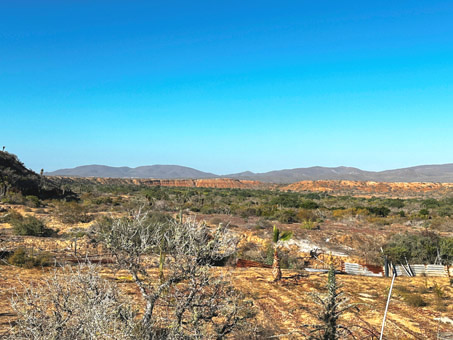 October 2023 — This had to be the hottest trip we've made in a number of years. From California's Central Valley all the way through southern California and northern Baja California, we sweated through most days under triple digit temperatures.
October 2023 — This had to be the hottest trip we've made in a number of years. From California's Central Valley all the way through southern California and northern Baja California, we sweated through most days under triple digit temperatures.
While on the road around 11 am south of San Felipe, it was so hot and the sun so brilliantly intense that we just kept on driving rather than stopping for any longer than it took to work out the kinks, take a photo or two and refill the water bottles.
It wasn't until we were almost at the Pacific coast in southern Baja California (Norte) around 2 pm that the temperature plummeted from 108° F to 92° F over just 15 minutes and 10 miles.I can't remember ever having said to anyone, upon climbing out of the car at their house on a 92° day, how refreshingly cool the air felt!
The drop in temperature was due not only to the proximity to the Pacific (just a few miles over the hill to the west of our friends' rancho), but also to the moisture from the outermost bands of Hurricane Norma that was currently bearing down on the southern tip of the peninsula about 450 miles from us.
It was the fastest trip we've ever made on that section of the peninsula between San Felipe and Guerrero Negro, just four and a half hours, instead of the usual six to eight we take due to the constant botanical distractions.
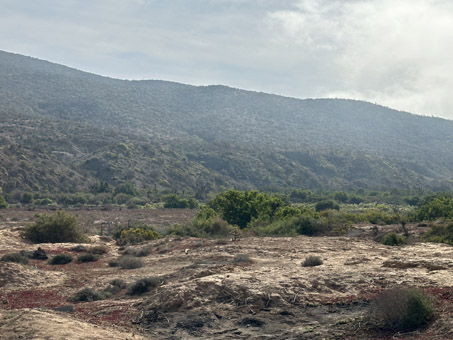
Moisture suddenly materialized late afternoon, moving in from the direction of the coast, and within the hour it was under 70° F. Ahhh...
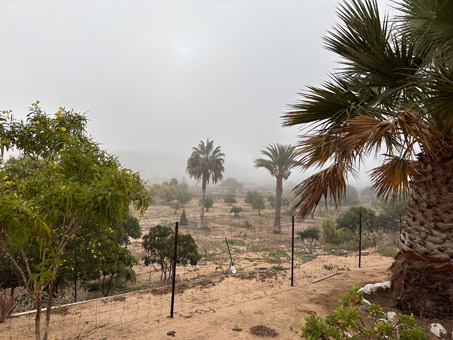
Cameras these days just never do justice showing how dense the fog really is close up. I could hardly see the two palms (middle).
The next morning we woke to heavy fog and the drip, drip, drip of heavy dew. When I first looked out the bedroom window, still half asleep, my friend sitting out in her garden appeared ethereal in her dark robe, the wisps of fog floating around her and softening and blurring her outline.
The heavy coastal fog is an important source of moisture for this region and the lichens and epiphytic Ball Moss (Tillandsia recurvata, Bromeliaceae) can reach epic proportions on some plants, often giving them a bearded appearance. I´ve found them to really be the most notable part of this region since most flowers are only ephemeral.
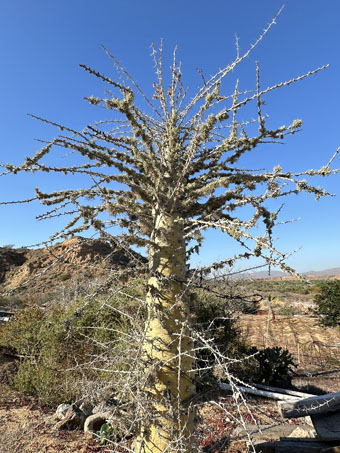
Boojum Tree/Cirio (Fouquieria columnaris). The density of the lichens (some appropriately called 'Fog Lichens') is incredible.
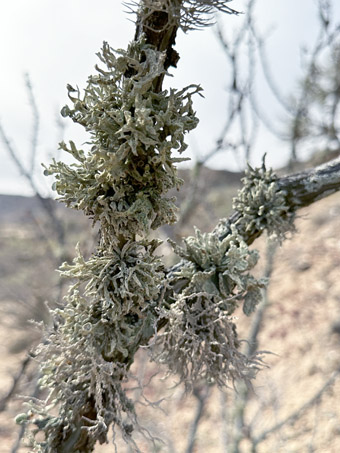
Closer view of some Fog Lichens on a Palo Adán (Fouquieria diguetii) shrub. Both of these species have slender, thorny branches, a perfect lichen substrate.
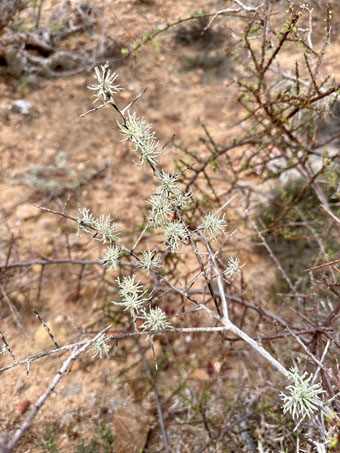
This is how it all starts off, so innocently with just a few lichen tufts here and there on the branch. (Vermilicinia ceruchis).
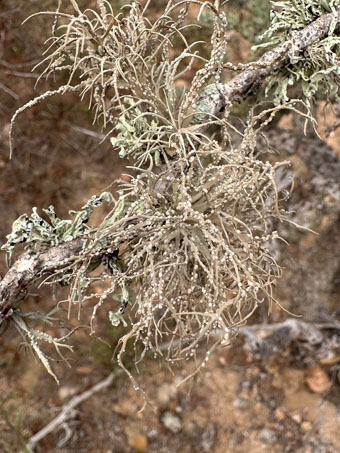
Then other friends join in and pretty soon they are all getting cozy on the branch. (Roccella gracilis & maybe Niebla homalea).
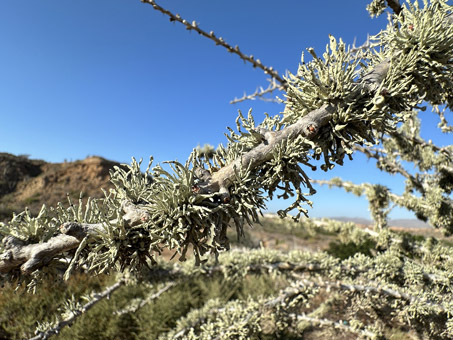
It's party time and they are so out of control.
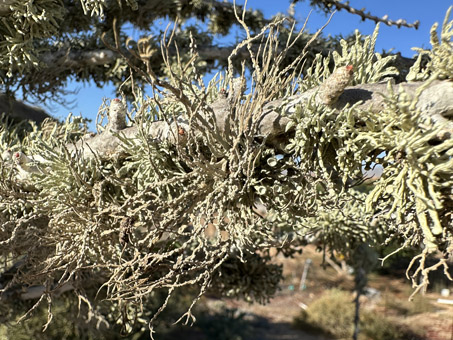
There is a branch somewhere under all those lichens.
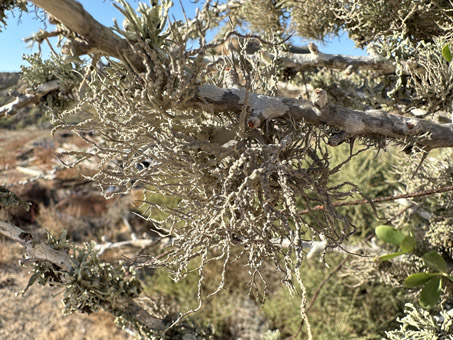
Here we've also got crustose lichens getting in on the act...
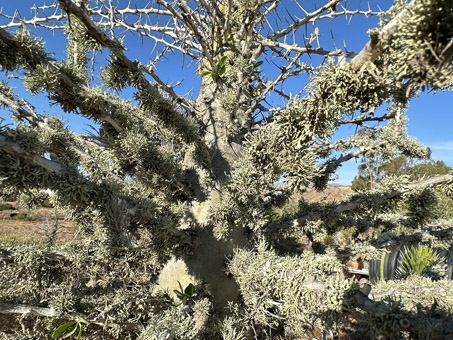
Who knows how long all this goes on before the shrubs start to look a lot like conifers...?
The ranch is a wonderful place to look at the many plants and lichens of the Central Desert/Vizcaino Desert ecotone so I was up and out early to take advantage of the morning cool and botanize before the sun and heat returned. More images of the area near the ranch as well as other plants and lichens can be found in a past Bee issue here. And for a full list of this month's plants and lichens (with family, Latin name and common names in both English and Spanish), visit this page.
The foggy morning was perfect for wandering around the ranch with the camera. Little gems kept popping up as I looked closely at the ground and between the many dry, seemingly dead, branches and twigs.
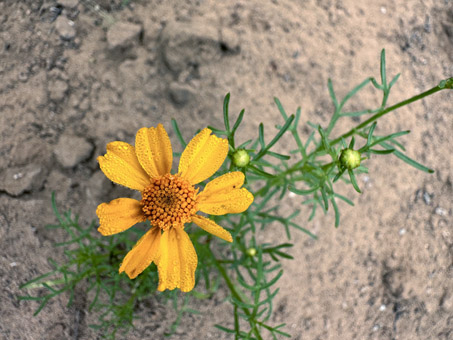
The upper surface of this comp, Peninsular Dyssodia / Hediondilla, (Boeberastrum anthemidifolia) is dotted with dew. Peninsular endemic.
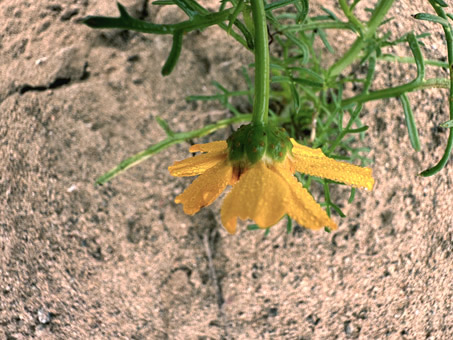
The lower surface is also dewy, but here what looks like droplets on the phyllaries are actually oil glands that give the plant its foul odor.
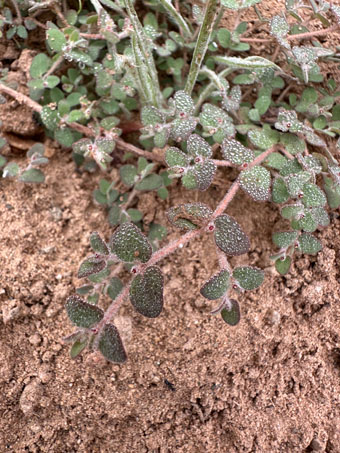
Gulf Sandmat / Golodrina (Euphorbia petrina). This is the same species I saw in Nov. 2022 near San Felipe that had lots of red-striped fruit and few flowers.
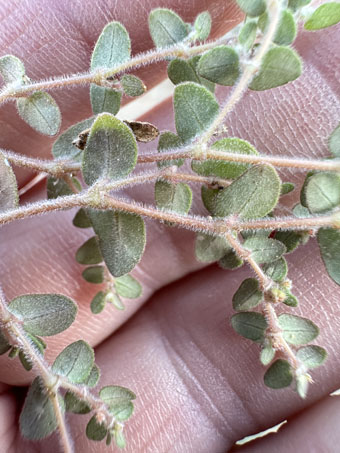
It was the different look of the fruit and the densely hairy stems & leaves of Gulf Sandmat that caught my attention that first time.
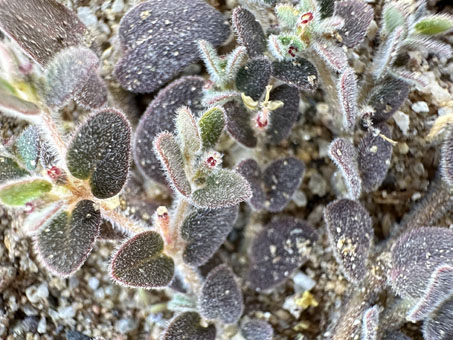
The flowers of Gulf Sandmat are minute. The cyathia is cylindrical, 2-3 mm L, with 4 maroon glands that seem to lack an appendage. Many of the leaves appear cordate at the base & older leaves can be purplish under the dense hairs.
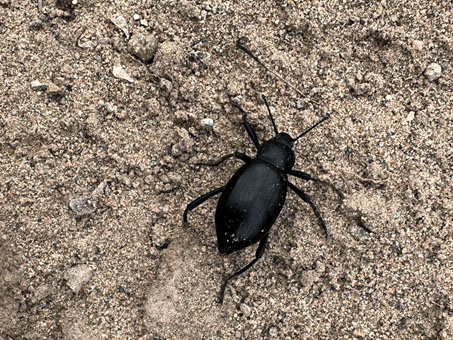
Desert Stink Beetle / Pinacate (Eleodes mexicana). They are common & seem to be esp. abundant where there is coastal fog. We've seen them day or night wandering around; don't be surprised if you find one hiding under an item left on the ground overnight.
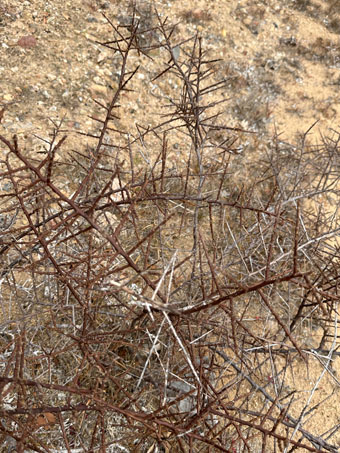
I was briefly stumped by this completely bare shrub with sharp, spinose branches because of the reddish color. Then again, it was early and I was still groggy after yesterday's exhausting heat and drive.
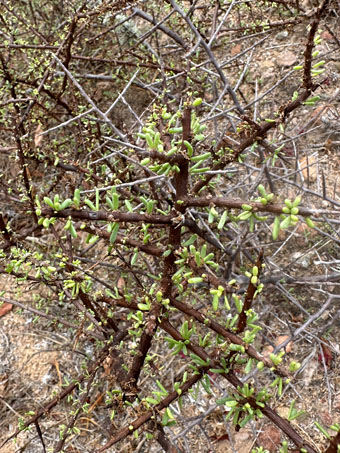
It all became clear when I chanced upon this leafy specimen. Of course! It was a California Desert Thorn / Frutilla (Lycium californicum var. californicum), a fairly common species throughout the peninsula.
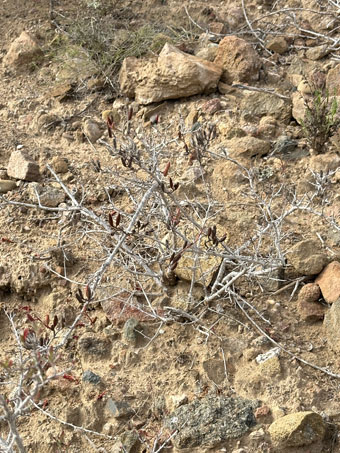
Another leafless shrub, Vizcaíno Xylonagra (Xylonagra arborea subsp. wigginsii). ID was easy since a few of the stems had either dried flowers or fruit. Look closely and you can see the reddish fls on the ground & fr on the stems. See here for photos of the flowers and more information.
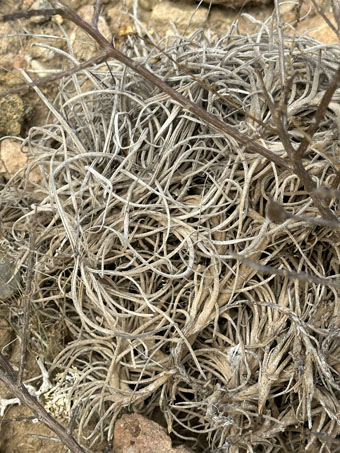
I couldn't tell if this tangled mass of the epiphytic Ball Moss (Tillandsia recurvata, not a moss but in the bromeliad family) had been blown off of a taller shrub or if was actually holding on to the prostrate Bursera microphylla that can be seen poking up through it.
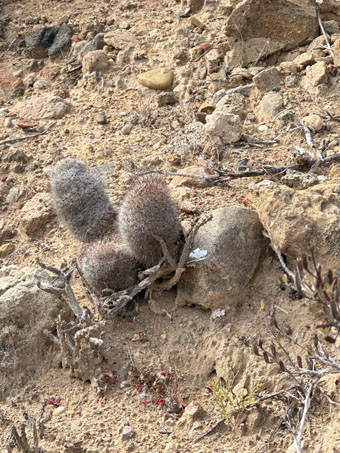
A small colony of Pincushion Cactus/Viejitos (Mammillaria dioica). On its right is the endemic Lindsay Cholla (Cylindropuntia lindsayi) and poking out from the far right side is more Xylonagra.
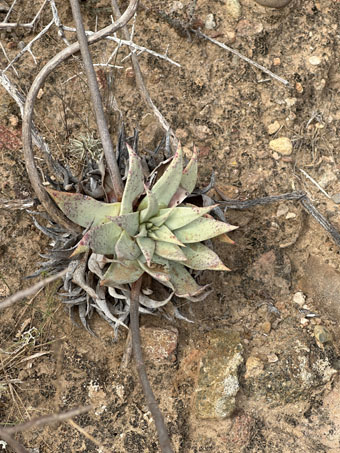
Vizcaino Live-forever (Dudleya acuminata), a peninsular endemic, is found in the Vizcaino & Central deserts of extreme s BC & far n BCS. Flowers are yellowish (see here & here).
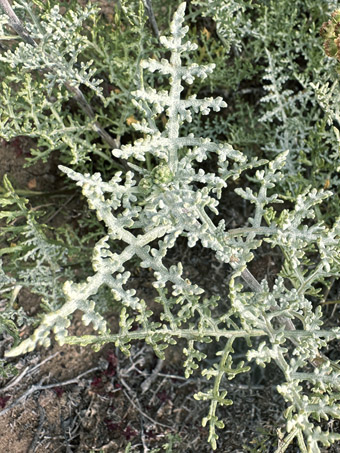
Magdalena Ragweed / Estafiate (Ambrosia magdalenae) is found from around Catavina into the Central Desert and disjunctly southward to the Cape region on both coasts. See more images of this species.
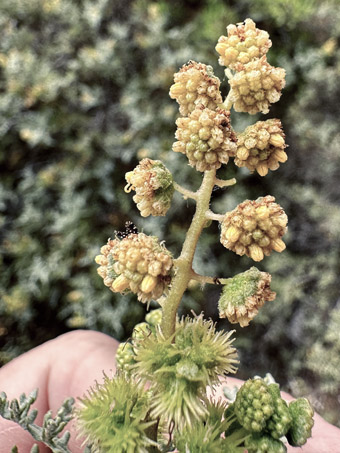
Staminate fl heads (upper) 6-8 mm D; pistillate burs (lower) 2-5-flowered with many terete, channeled spines, most with hooked tips. Like A. dumosa, new leaves are cinereous & the older bark white.
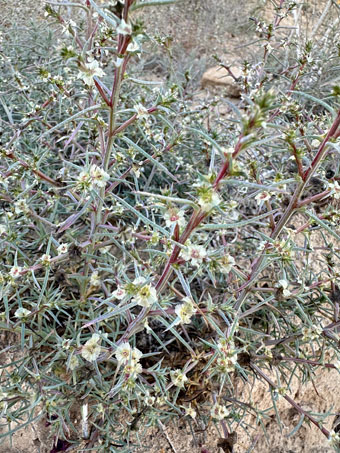
The beginnings of a Russian-thistle, Salsola tragus, a common agricultural weed introduced from Eurasia.
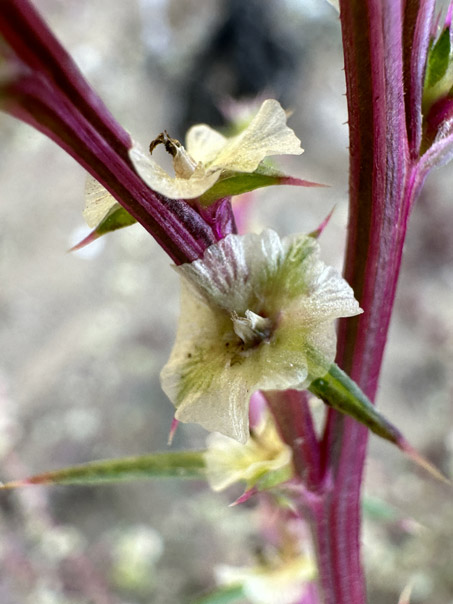
Russian-Thistle (Tumbleweed) is a thorny, annual herb. Those leaf tips are sharp! The 5 calyx lobes become papery wings in fruit.
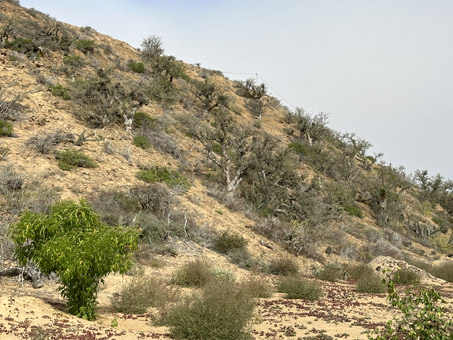
Hillside at the ranch with typical vegetation as described above and below, plus: Copalquin (Pachycormus discolor var. pubescens), Goldman Agave (Agave shawii subsp. goldmaniana), Galloping Cactus (Stenocereus gummosus) & Old-man Cactus (Lophocereus schottii).
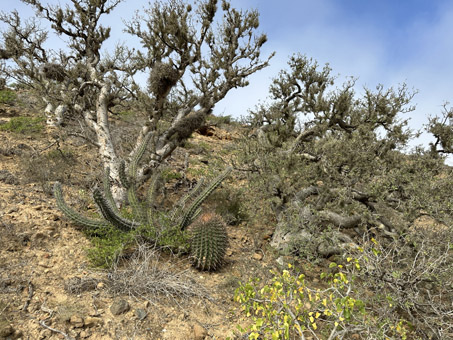
Same hill but closer. Many of the plants bear lichens. The tall trees are Copalquín. Galloping Cactus, Littleleaf Elephant Tree & Red-spine Barrel Cactus are at center. Lomboi (Jatropha cinerea) is at center-front.
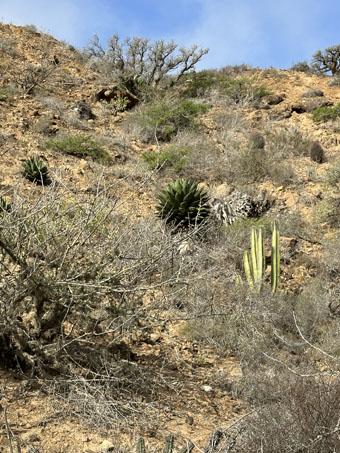
Another section of the same hillside, here with Old-man Cactus, Goldman Agave, Copalquín, Four-wing saltbush (Atriplex canescens) and Palo Adán.
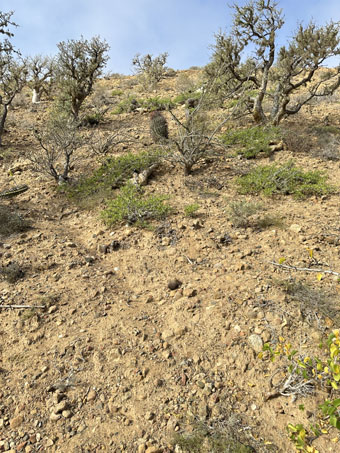
Looking up the slope of the hillside, the 5-6 low, bright green plants are Littleleaf Elephant Trees. Copalquín trees loom above & behind them.
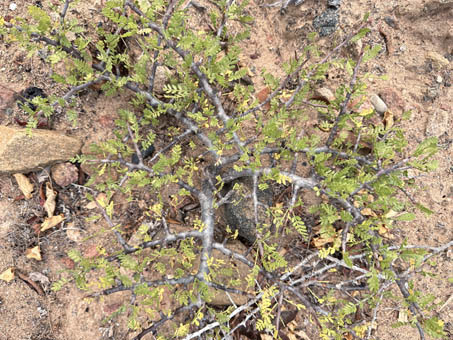
Prostrate Elephant Tree / Torote Colorado (Bursera microphylla), not much more than 30 cm H, looks more like a low shrub on this hillside.
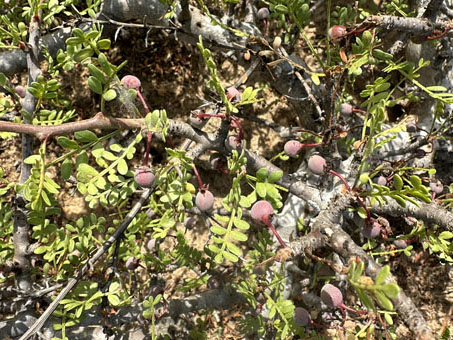
Littleleaf Elephant Tree fruit. The 8-12 mm drupes are important food sources for rodents and birds from fall to spring .
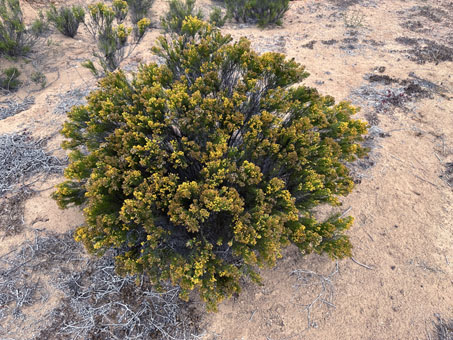
Sonoran Goldenbush / Romerillo Amargo or Hierba del Pasmo (Gundlachia diffusa) is abundant here at the ranch. The plants in this area always seem to have darker leaves and flowers than those around Mulegé and elsewhere along the Gulf coast.
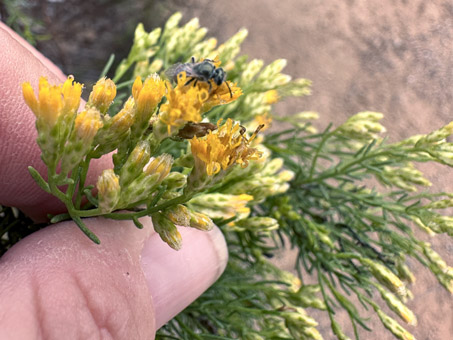
Romerillo Amargo flowers are composites that lack rays and have a few small disk flowers. There is a small native bee feeding on the nectar. It ranges from around Punta Prieta & Bahía de los Ángeles (to the north of the ranch) all the way to the Cape region.
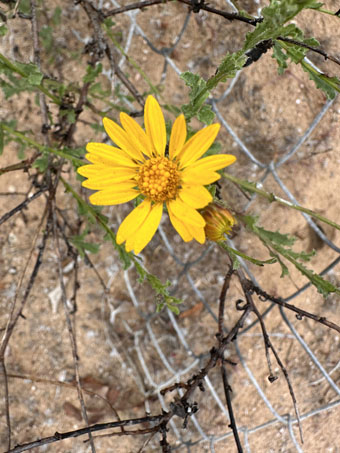
Peninsular Tansy-Aster / Cola de Zorilla (Xanthisma scabrellum), a small shrub, was abundant on the hillsides around the ranch. The composite flower is about 25-30 mm D.
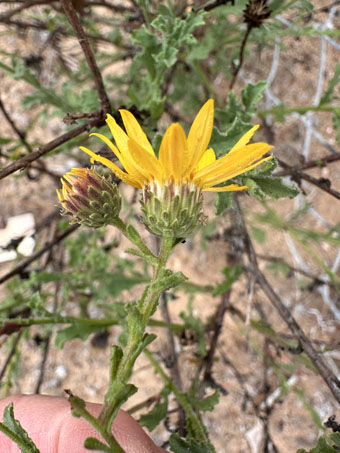
Peninsular Tansy-Aster herbage is both scabrous and glandular. High res. photos of this plant can be seen here. This endemic is found from c BC to the Cape.
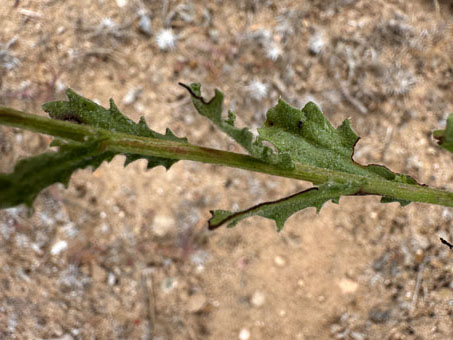
Many of the leaf lobes as well as the phyllaries (modified leaves found on the involucre of Peninsular Tansy-Aster have tiny spines.
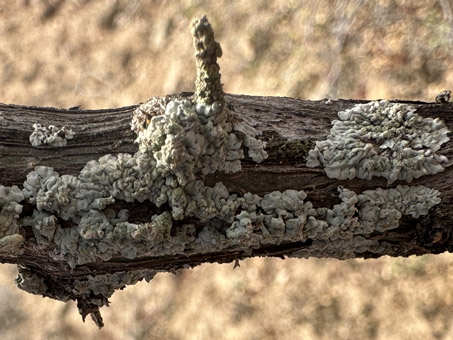
An undetermined foliose lichen on a Palo Adán branch. It is gray-green with many ovate sections. This section about 4-5 cm L
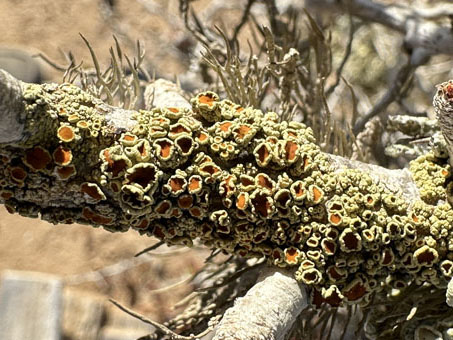
This fruticose, bark-dwelling lichen (Polycauliona polycarpa) is common in the fog zones along the W coast of the peninsula. Here the thallus is yellow-green w/ orange apothecia. It varies from this, to orange all over.
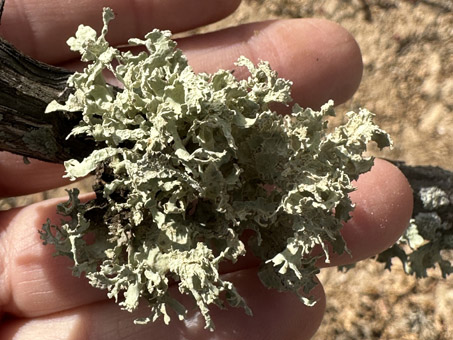
This is a yet to be determined foliose lichen on a Palo Adán branch. The thallus branches were compressed, 3-4 mm W with lacunae. It lacked the pycnidia (seen as small black dots) of a nearby Niebla ceruchis.
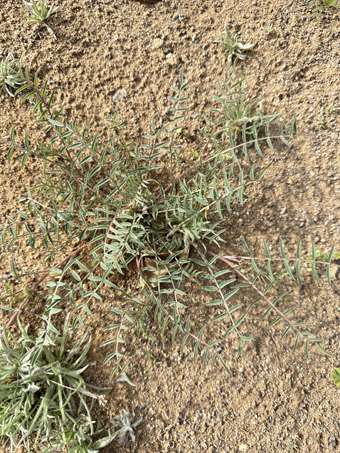
This small plant, about 25 cm D is likely Cedros Milkvetch (Astragalus insularis), a peninsular endemic found from s BC to n BCS as well as Cedros and San Lorenzo islands.
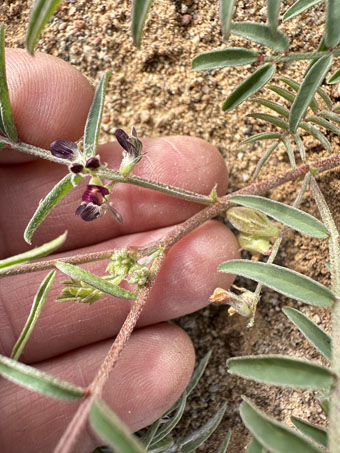
The tiny flowers of Cedros Milkvetch were c. 5-6 mm L, pink/purple with white. The inflated, papery, ovoid fruit were c. 10-15 mm L (see high res. images at iNaturalist).
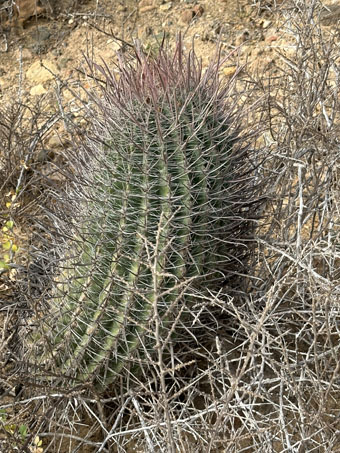
Red-spine Barrel Cactus (Ferocactus gracilis var gracilis). The variability of this species is exasperating!
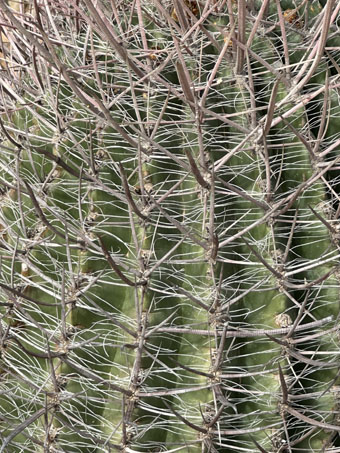
The principal central spines of this individual were long, slightly compressed near the base, and somewhat curved & twisted near the tip.
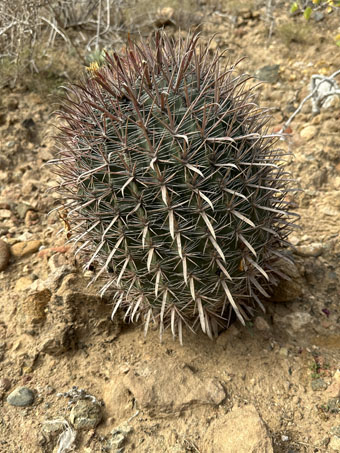
Whereas this Red-spine Barrel individual had a somewhat shorter, broad & strongly flattened central spine that created a striking pattern.
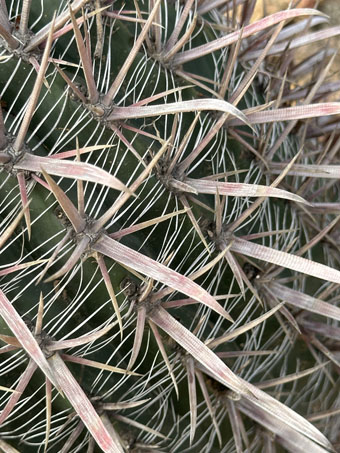
Close-up of the spines. Red-spine Barrel Cactus has 4-6 central spines, with one usually more prominent. The radial spines are bristly, as are those of F. peninsulae.
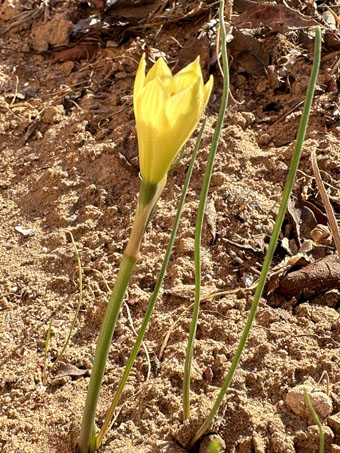
Copper Zephyr Lily / Cebolla de Mayo (Zephyrantes longifolia, Amaryllidaceae) is a scapose herbaceous herb (from a bulb) that makes its appearance commonly after good summer rains, like those from Hurricane Kay that passed by here a month ago.
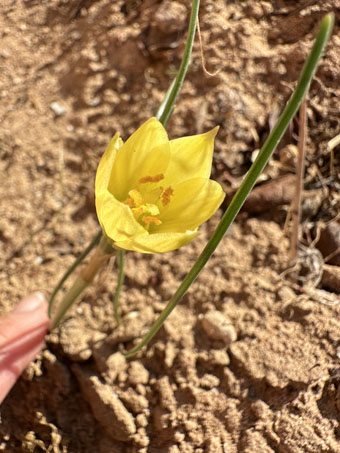
Copper Zephyr Lily is 15-30 cm H, with 3-10 basal, filiform leaves (1 mm W). The solitary funnelform flower has six yellow perianth segments each c. 20-28 mm L, and is subtended by a papery spathe.
That's it for this month. Next time I will have some plants from my first botany forays after we arrived in Mulegé. Until then, hasta pronto...!
Debra Valov — Curatorial Volunteer
References and Literature Cited
iNaturalist. Available from https://www.inaturalist.org. (Accessed December 2023)
Rebman, J. P., J. Gibson, and K. Rich, 2016. Annotated checklist of the vascular plants of Baja California, Mexico. Proceedings of the San Diego Society of Natural History, No. 45, 15 November 2016. San Diego Natural History Museum, San Diego, CA. Full text available online.
Rebman, J. P and Roberts, N. C. (2012). Baja California Plant Field Guide. San Diego, CA: Sunbelt Publications. Descriptions and distribution.
Valov, D. (2020). An Annotated Checklist of the Vascular Plants of Mulegé, Baja California, Mexico. Madroño 67(3), 115-160, (23 December 2020). https://doi.org/10.3120/0024-9637-67.3.115
Wiggins, I. L. (1980). The Flora of Baja California. Stanford University Press. Keys and descriptions.


















































